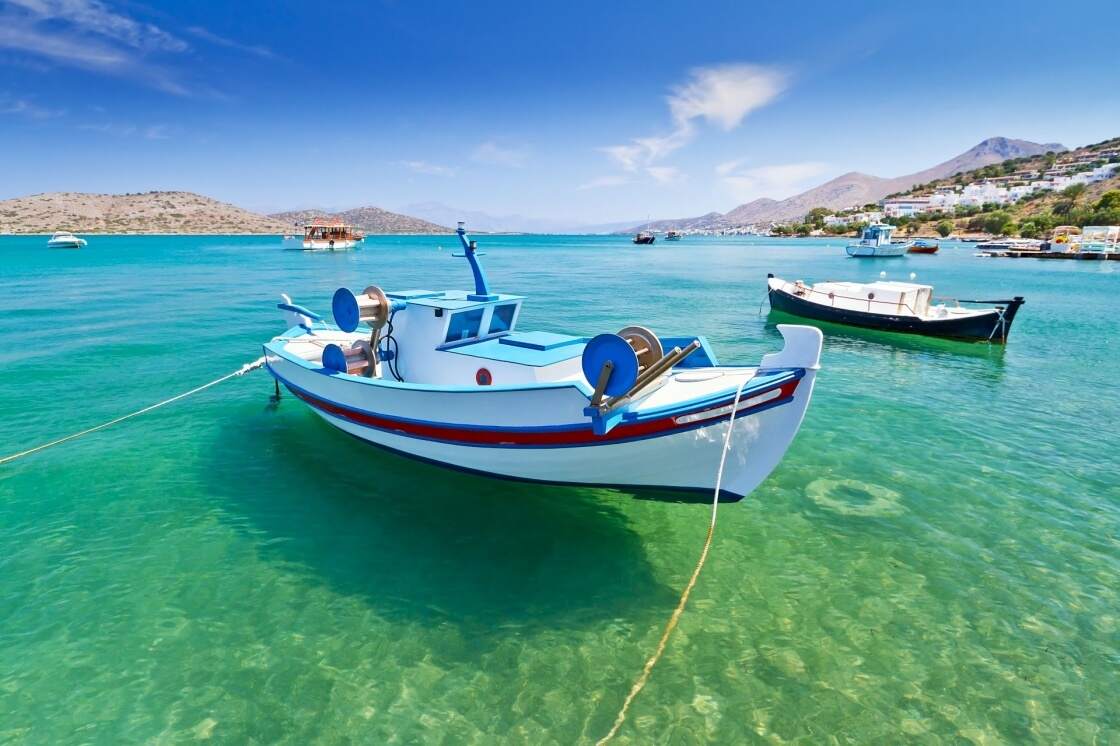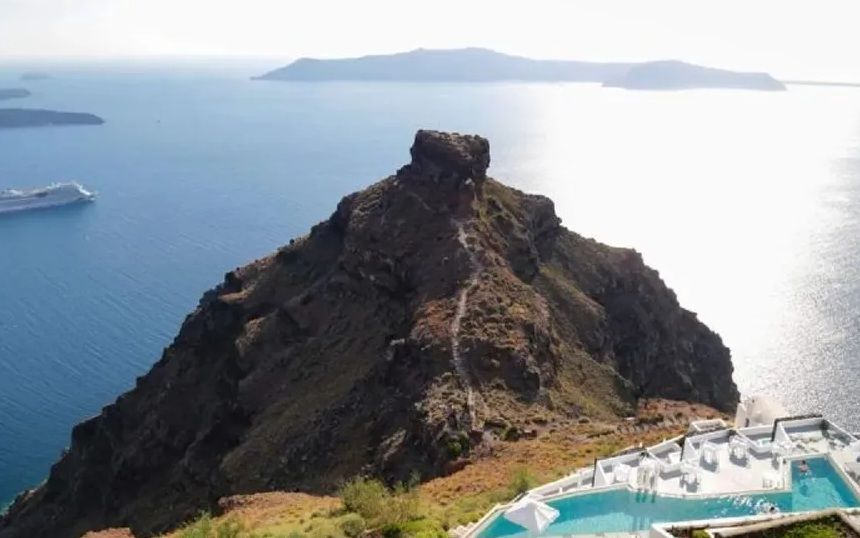Travelling from Heraklion to Santorini: Complete Ferry & Travel Guide
Travel Guides
Travel Guides


The journey from Heraklion to Thira (Santorini) is one of the most scenic routes in the Greek islands, connecting Crete's vibrant capital with the iconic volcanic landscapes of Santorini. This popular Mediterranean passage spans approximately 109.5 km (68 miles) across the sparkling Aegean Sea. Whether you're planning a Greek island-hopping adventure or a dedicated visit to Santorini's famous caldera, this route offers a convenient connection between these two stunning destinations. While flights are available, the ferry journey provides a uniquely immersive travel experience that allows you to appreciate the beauty of the Aegean.
In this comprehensive guide, we'll explore your transportation options, with a focus on the ferry services that connect these two popular Greek destinations.
When travelling from Heraklion to Santorini, you have two main transportation options: flying or taking a ferry. Each offers distinct advantages depending on your travel preferences, budget, and schedule.
Flying between Heraklion and Santorini is an option for travellers prioritising speed, though flight schedules can be limited and prices tend to be higher than ferry travel. The actual flight time is quite short, but when factoring in check-in times and airport transfers, the time advantage may be less significant than it initially appears.
Ferry travel, on the other hand, is the most popular and scenic way to make this journey. The ferry route from Heraklion to Santorini covers approximately 59.1 nautical miles across the Aegean Sea. With an average duration of 1 hour and 43 minutes, the ferry offers a relaxed travel experience where you can enjoy panoramic sea views, fresh air on deck, and the gradual approach to Santorini's dramatic caldera - a sight that has captivated travellers for generations.
The route typically sees about 1 sailing daily, with approximately 5 sailings per week and 24 sailings per month. This consistent schedule makes ferry travel a reliable option for planning your Greek island adventure. While not as fast as flying, the ferry journey offers a more authentic maritime experience and the convenience of arriving directly into the heart of Santorini.
You can take a ferry from Heraklion to Santorini. Ferries sail in around 1 hour and 43 minutes with about 1 sailing a day. The fastest ferry sails in around 1 hour and 35 minutes and is provided by SeaJets. Ferry prices can range with the average price being around £356 depending on the season and booking time. Departures start as early as 03:15, with the last departure from Heraklion to Thira (Santorini) at 23:45.
SeaJets is the primary operator offering the fastest connection on this route. Their high-speed vessels reduce the journey time to just 1 hour and 35 minutes, making it possible to maximise your time in Santorini. These modern ferries are equipped with comfortable seating areas, cafes serving refreshments and light meals, and outdoor deck spaces where you can enjoy the Mediterranean breeze and stunning seascapes.
Onboard amenities typically include air-conditioned lounges, cafeterias or snack bars, restroom facilities, and sometimes duty-free shopping options. Many ferries also offer premium seating options for those seeking additional comfort during the journey.
The ferry schedule varies by season, with more frequent services during the summer months (June through September) when tourism peaks in the Greek islands. If you're travelling during this high season, we recommend booking your ferry tickets well in advance to secure your preferred sailing date and time. The shoulder seasons of late spring and early autumn offer a good balance of pleasant weather and less crowded ferries.

Heraklion Port (also known as Port of Heraklion or Iraklion Port) is located on the northern coast of Crete, conveniently situated near the city centre. From central Heraklion, the port is approximately a 10-15 minute walk or a very short taxi ride.
If you're staying elsewhere on the island, you can reach the port via public bus services that connect most major towns and resorts to Heraklion city. For those arriving directly from Heraklion International Airport, the distance to the port is about 5 km (3 miles), which takes around 15 minutes by taxi or 30 minutes by public bus.
The port facilities include a passenger terminal with basic amenities such as waiting areas, restrooms, and a few cafes and kiosks. There are also tourist information points, ATMs, and taxi stands nearby. If you're travelling with a vehicle, there is parking available near the port, though spaces can be limited during peak season.
We recommend arriving at least 45-60 minutes before your scheduled departure to allow time for check-in and boarding procedures, especially during the busy summer months when the port can become quite crowded.
Arriving at Santorini's Athinios Port (the main ferry port), you'll be greeted by the island's dramatic volcanic cliffs. The port itself is located at the bottom of a steep cliff on the western side of the island, about 8 km (5 miles) from Fira, the island's capital.
Due to the port's location at the base of a cliff, transportation from the port to your destination is essential. Options include:
Local buses that connect the port to Fira, from where you can catch connecting buses to other parts of the island. These buses typically coordinate their schedules with arriving ferries, but can get crowded during peak season.
Taxis are available at the port, though their number is limited. During busy periods, you might need to wait or share with other travellers.
Pre-arranged hotel transfers are highly recommended, especially if you're arriving during high season or with substantial luggage.
Rental cars and scooters can be picked up from agencies with desks at the port, but these should ideally be booked in advance.
The port itself has basic facilities including a few cafes, travel agencies, ATMs, and restrooms. However, it's not designed as a place to linger, and most visitors quickly make their way up to the towns above.
A day trip from Heraklion to Santorini is technically possible but would require careful planning and an early start. With the earliest ferry departing at 03:15 and the journey taking approximately 1 hour and 43 minutes, you could arrive in Santorini by early morning. However, considering the late departure times back to Heraklion (as late as 23:45), you would have a substantial amount of time to explore the island.
A realistic day trip itinerary might look like this:
Early morning: Depart from Heraklion on the first available ferry Morning: Arrive in Santorini and take transportation to Fira Late morning: Explore Fira, including its charming streets and caldera views Midday: Enjoy lunch at a restaurant with caldera views Afternoon: Take the bus to Oia to explore its famous blue-domed churches and perhaps stay for the renowned sunset Evening: Return to Athinios Port for your ferry back to Heraklion
While this schedule is possible, we generally recommend staying at least one night in Santorini to fully appreciate the island without rushing. The unique charm of Santorini reveals itself in the early mornings and evenings when day-trippers have departed, and the magical light illuminates the whitewashed buildings.
If you're determined to make a day trip work, consider booking a guided tour that includes round-trip ferry tickets and an organised itinerary to maximise your limited time on the island.
Santorini offers an abundance of experiences for every type of traveller. Here are the top attractions that make this island a must-visit destination:
The dramatic cliffside views of the volcanic caldera are Santorini's signature attraction. The best viewpoints are found in Fira, Imerovigli, and Oia. Take a leisurely walk along the caldera path connecting these villages for continuously changing perspectives of this natural wonder. Accessible all day, though sunset views are particularly spectacular.
Famous for its blue-domed churches, whitewashed buildings, and stunning sunsets, Oia represents the postcard image of Santorini. Explore its narrow marble-paved alleys, upscale boutiques, and art galleries. Visit in the early morning or evening to avoid crowds, or brave the sunset crowds for the classic Santorini experience.
This remarkably preserved Bronze Age settlement was buried under volcanic ash around 1600 BCE. Often called the 'Prehistoric Pompeii,' it offers a fascinating glimpse into an advanced Minoan civilisation. Open daily except Mondays, from 8:00 to 17:00.
Santorini's unique volcanic history has created distinctive beaches with red, black, and white sand. Visit Perissa or Kamari for organised black sand beaches with amenities, Red Beach for its dramatic red cliffs, or White Beach for a more secluded experience accessible by boat.
Santorini's volcanic soil produces distinctive wines, particularly the crisp, mineral-rich Assyrtiko. Visit traditional wineries like Santo Wines, Venetsanos, or Domaine Sigalas to sample local varieties while enjoying caldera views. Most wineries offer tours and tastings throughout the day.

Fira: The island's capital combines shopping, dining, nightlife, and caldera views. It's centrally located and well-connected by public transportation to other parts of the island.
Oia: The most picturesque and upscale village, famous for sunsets and luxury accommodations. It's quieter than Fira but still offers excellent dining and shopping.
Imerovigli: Known as the 'balcony to the Aegean,' this village offers some of the most spectacular caldera views in a more peaceful setting than Fira or Oia.
Kamari and Perissa: These beachside villages on the eastern coast offer black sand beaches, more affordable accommodations, and a relaxed atmosphere away from the caldera crowds.
Pyrgos: This inland village with its well-preserved medieval architecture provides an authentic glimpse into traditional Santorinian life, with fewer tourists and excellent panoramic views.
Santorini enjoys a Mediterranean climate characterised by hot, dry summers and mild, slightly wetter winters. This creates ideal conditions for tourism through much of the year.
Summer (June to September) brings consistently hot and sunny weather with temperatures ranging from 23-29°C (73-84°F). Rainfall is extremely rare during these months, and the Meltemi winds provide welcome relief from the heat, particularly in July and August. This is peak tourist season when the island is at its busiest.
Spring (April to May) and autumn (October to November) offer pleasant temperatures between 15-25°C (59-77°F) with fewer crowds. These shoulder seasons are ideal for exploring the island comfortably, though sea temperatures may be cooler for swimming in spring.
Winter (December to March) is mild with temperatures rarely dropping below 10°C (50°F), but this is also when most rainfall occurs. Many tourist facilities close during this period, though the island takes on a peaceful, authentic character that some travellers prefer.
Regarding ferry operations, the weather generally affects services most during the winter months when strong winds and rough seas can occasionally cause cancellations or delays. The high-speed ferries like those operated by SeaJets are more susceptible to weather disruptions than larger, conventional vessels. During summer, ferry services are very reliable, though the occasional Meltemi wind can cause minor schedule adjustments.
Santorini is known as one of the more expensive Greek islands, particularly in the caldera-view villages of Oia, Imerovigli, and Fira. However, with careful planning, you can enjoy this stunning destination across various budget levels.
For budget travellers, expect to spend a minimum of £100-150 per day, staying in modest accommodations away from the caldera (perhaps in Kamari, Perissa, or Karterados), using public transportation, and dining at local tavernas. Budget accommodations start around £50 per night in low season.
Mid-range travellers should budget £150-300 daily for comfortable accommodations with partial sea views, occasional taxi use, and a mix of casual and nicer restaurants. A typical mid-range meal costs around £20-30 per person without drinks.
Luxury travellers can easily spend £300+ daily, with premium caldera-view suites starting at £300-500 per night in high season. Fine dining restaurants with caldera views typically charge £50-100+ per person.
Money-saving tips include visiting during shoulder seasons (May, early June, late September, October), staying in villages away from the caldera, using the efficient bus system (single rides cost around £2), and enjoying the many free viewpoints and hiking opportunities.
The best time to visit Santorini depends on your priorities regarding weather, crowds, and budget.
Peak season (late June through early September) offers guaranteed sunshine and warm sea temperatures perfect for swimming. However, this is when the island is most crowded and expensive, with premium accommodations often booking out months in advance. July and August see the highest temperatures, sometimes exceeding 30°C (86°F).
Shoulder seasons (April to early June, late September to October) provide an excellent balance of pleasant weather, reduced crowds, and lower prices. May and October are particularly lovely, with comfortable temperatures around 20-25°C (68-77°F), good visibility for photography, and the ability to explore popular sites without overwhelming crowds.
Low season (November to March) offers the most authentic experience of local life and the lowest prices, with many accommodations discounted by 50% or more. While swimming isn't ideal and some businesses close, major sites remain open, and you'll have the famous views largely to yourself. Be prepared for cooler temperatures and a higher chance of rain.
For photographers, April-May and September-October offer the best light conditions and clear air. For honeymooners seeking a balance of good weather and relative privacy, early June and late September are ideal. Wine enthusiasts might plan around the grape harvest in late August and early September, while hikers will appreciate the wildflower blooms of April and May.
Whatever time you choose to visit, the ferry journey from Heraklion provides a wonderful introduction to this magical island, allowing you to approach Santorini's majestic caldera from the sea – just as visitors have done for centuries.
Finding the perfect place to stay in Santorini after your ferry journey from Heraklion is an important part of your Greek island experience. The island offers accommodations for every budget and preference.
For travellers watching their expenses, Perissa and Kamari areas offer more affordable accommodations, with rooms starting from around £50 per night in the shoulder season. These black-sand beach locations provide excellent value while still offering the quintessential Santorini experience.
Couples seeking romance might prefer the caldera-view hotels in Fira or Imerovigli, where a standard room with partial sea views starts at approximately £120-200 per night. For the ultimate luxury experience, the cliffside suites in Oia with private plunge pools typically range from £300-800 per night.
Families will find spacious apartments and villas in Kamari and Perivolos, offering kitchen facilities and proximity to family-friendly beaches. These accommodations provide more space and typically range from £100-250 per night depending on size and season.

Once your ferry from Heraklion arrives at Santorini port, you'll need to navigate the island efficiently to make the most of your stay.
Santorini has a reliable bus network connecting major towns and attractions, with fares around £1.80-2.50 per journey. Buses run frequently during summer months but have reduced schedules in winter. The central bus station is located in Fira, making it a convenient hub for travels across the island.
Taxis are available but limited in number. A taxi from the port to Fira costs approximately £15-20, while reaching Oia might cost £25-35. Pre-booking a private transfer is recommended, especially during peak season or if arriving late.
Renting a vehicle gives you the freedom to explore at your own pace. Car rentals start from around £30-40 per day, while ATVs and scooters offer a more adventurous option at £20-30 daily. Note that Santorini's roads can be narrow and winding, particularly around the caldera.
The journey from Heraklion to Santorini by ferry opens up a world of stunning landscapes, unique experiences, and unforgettable memories. Whether you choose the ultra-fast 1 hour 35 minute crossing with SeaJets at around £356 or opt for one of the other regular services operating on this 59-nautical-mile route, the sea journey itself becomes part of your Greek islands adventure.
With five weekly sailings and convenient departure times ranging from early morning to late evening, planning your trip between these two magnificent destinations has never been easier. The ferry allows you to soak in the breathtaking approach to Santorini's dramatic caldera—a view that flight passengers miss entirely.
Book your ferry tickets in advance, especially during the peak summer months when the 24 monthly sailings can fill up quickly. Your seamless journey across the Aegean Sea awaits, connecting you from the historical richness of Crete to the postcard-perfect vistas of Santorini.